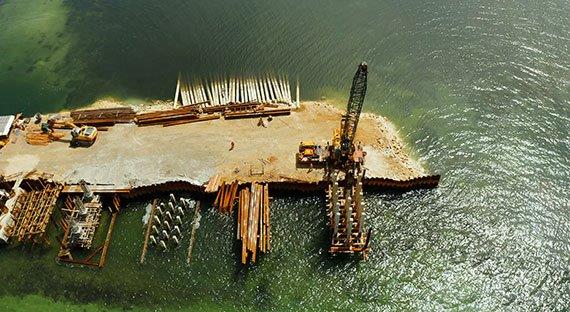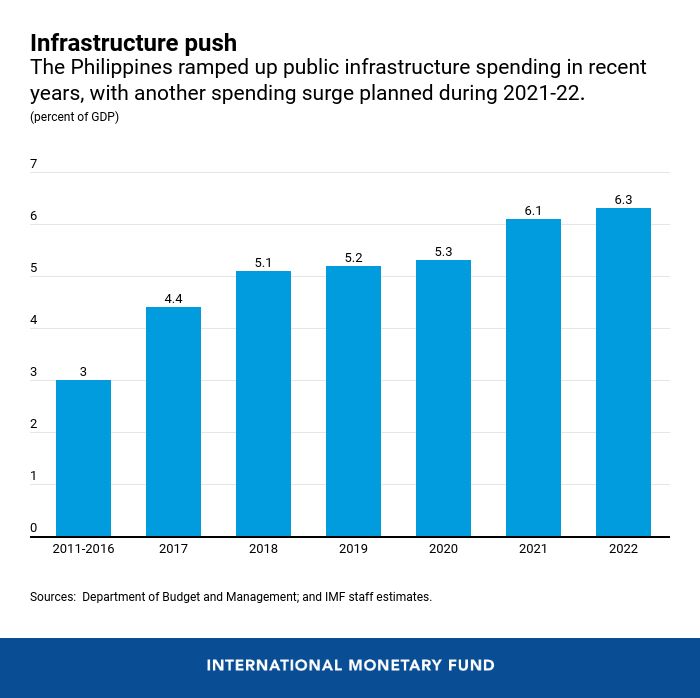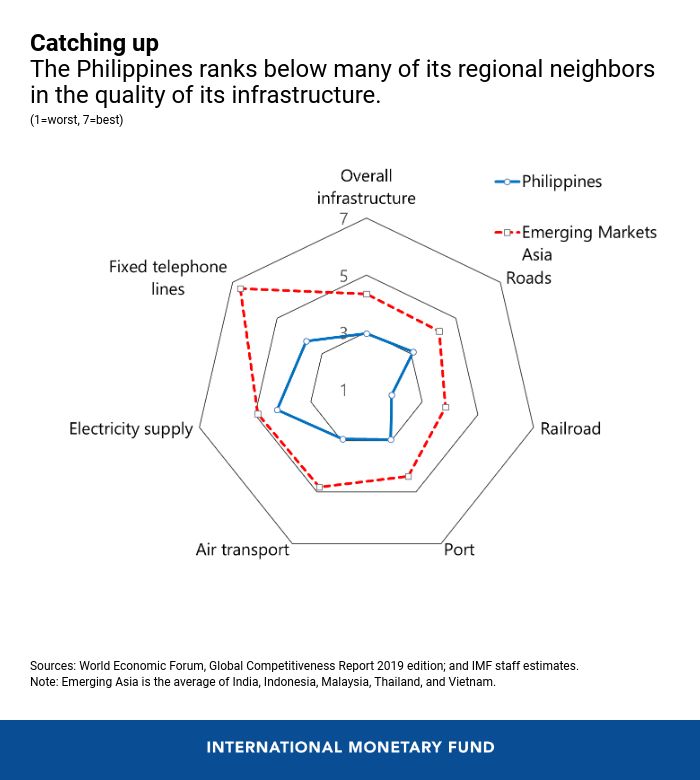
Bridge under construction across the bay at Siargao, Philippines. The government’s <i>Build Build Build</i> program includes large projects that address transportation bottlenecks (photo: iStock/Alexpunker)
The Philippines: A Good Time to Expand the Infrastructure Push
February 6, 2020
Infrastructure improvements will be crucial in the Philippines as the country looks to become an upper middle-income country and reduce poverty rates from 16.6 percent in 2018 to 14 percent by 2022.
Related Links
Structural economic reforms, along with sound macroeconomic policies, helped the Philippine economy to grow, on average, by 6.3 percent annually over the last decade. But sustaining and sharing the benefits of this growth among its citizens will require policymakers to focus their attention on issues such as costly geographical barriers to trade, high levels of poverty and income disparities, the rise of new digital technologies, and climate change
The Philippine economy ranks among the best performers in Asia in recent years. Still, the economy faces constraints from its outdated and insufficient infrastructure. According to some estimates, for example, it takes about five minutes to drive just one kilometer in Metro Manila.
Big push
To tackle the issue, the Philippines increased spending on roads, bridges, air and sea ports, and other large-scale projects in recent years. Public infrastructure investment rose from an average of 3 percent of GDP during 2011–16 to over 5 percent in 2018, with the target of raising the ratio to over 6 percent by 2022. The government’s Build Build Build program includes large projects that address major bottlenecks, focusing on transportation, water resources, and energy.

When completed, these projects are expected to bring important benefits to the Philippine economy and to the lives of ordinary citizens. Better transportation and internet services, for example, would help farmers bring their produce, such as bananas and mangos, to markets and raise the income of the rural population. More generally, improvements in the quality of infrastructure services will help cut the cost of doing business, attract more investment, and enhance productivity around the country.

Predicated on the infrastructure push and the ongoing economic policy reform efforts, private investment is projected to increase over time, leading to higher economic growth. Moreover, students and the sick and elderly will benefit from the investments in education and health care. Upgrades in public information technology infrastructure, such as e-invoicing and digital national identification cards, would also promote efficiency and transparency, helping to reduce corruption.
Increased investment to combat climate change and natural disasters will also bring substantial benefits. The Philippines is among the most vulnerable countries in the world to risks from climate change and natural hazards—typhoons, landslides, earthquakes, floods, droughts, and volcanic eruptions. The country’s vulnerability is exposed by the devastating impact of Typhoon Yolanda in 2013, which led to 6,300 deaths and, according to official estimates, some US$3 billion in damage and losses to the economy (more than one percent of GDP).
Climate-resilient infrastructure, efficient irrigation systems, and better water management will help lessen the impact of weather-related natural disasters and boost agricultural production, and potentially lift many people out of poverty.
Making better use of public resources
To succeed with the infrastructure push, the government will need to ensure its spending is well managed. A recent IMF Public Investment Management Assessment ranks the Philippines similarly to its regional peers, but observes an efficiency gap of about 23 percent compared with best practices in translating public investment into infrastructure. Closing this gap will require improving project appraisals, by identifying risk reduction measures early on and greater involvement of the public—for example, by publishing appraisal analyses for public comment. Moreover, more private-sector participation could help in executing the infrastructure investment push as long as financial risks to the government are well managed. Moreover, developing domestic capital markets could broaden the funding of the push.
Strengthening the public procurement process is another priority. Greater competition and transparency would help in managing costs and reducing risks of corruption. Imposing stricter sanctions, such as larger financial penalties and longer exclusion from future tendering, would help deter bid rigging in procurement. Likewise, allowing greater foreign participation in domestic projects would increase competition as well as help ease domestic capacity constraints.
Lowering obstacles to foreign investment would not only help the infrastructure push but also stimulate private investment. Despite recent progress, high barriers to foreign direct investment remain in the Philippines. Implementation of the ease-of-doing-business law would complement efforts to cut red tape as well as to increase transparency and accountability of regulatory agencies.
Finally, tax reform can help sustain the infrastructure push while safeguarding fiscal sustainability. The government’s recent tax reforms have led to a significant increase in revenue collection. But the remaining packages of reforms are important for further improvements in the tax system. Together with continued efforts to strengthen the tax system, these reforms will lay a foundation for inclusive growth by supporting sustainable investment in infrastructure and human capital.


